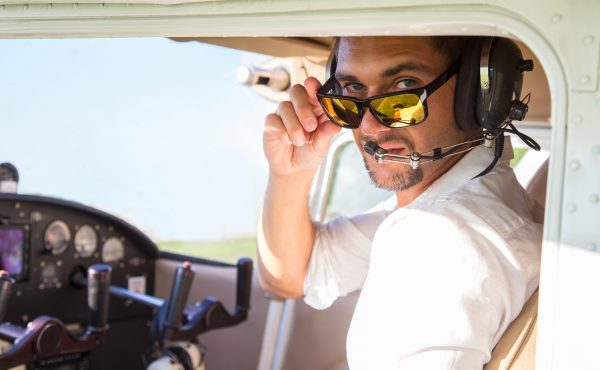
“On an unforgettable storm-filled October night in 1999, we were on approach into Little Rock National Airport, and it was bad.”
And so the story begins, as told to us by Ron T., a recovering alcoholic and commercial airline captain who has since retired and moved from Little Rock to Colorado.
“Go around max thrust flaps nine, positive rate gear up,” I commanded as the ground proximity warning blared “too low terrain.” My copilot froze while I struggled to overcome the inertia of fifty thousand pounds of airliner descending at twenty-two hundred feet per minute.
I was the captain flying this leg of a very long, five-leg day. This go-around maneuver is difficult in good weather, with both pilots doing their jobs. We had neither advantage.
“Anytime now, Chad,” I barked at my new-hire first officer. When I reached over to retract the flaps myself (his job), Chad reengaged and began to assist me.
The thunderstorm was four miles off the approach end of runway 4 right, and the controller had turned us in tight, about a three-mile final approach, to avoid the storm. The turbulence was so intense that the instrument panel appeared fuzzy. We were in low, thick clouds with zero visibility and heading for the same runway and similar weather conditions as the American Airlines MD-80 crash earlier in the year.
Our original destination was San Antonio, Texas. We had left Detroit with plenty of fuel, but had encountered such strong headwinds that we had consumed more fuel than expected. To make matters worse, the weather in Texas had deteriorated. San Antonio was reporting low clouds and very low visibility.
Our situation required us to have extra fuel to reach an alternate airport in case we couldn’t get into San Antonio. With the wind situation, we just barely had enough fuel to get there, and no extra fuel to reach an alternate if it was necessary.
“You have to stop in Little Rock for fuel,” the company dispatcher said on the radio.
“We just flew over Little Rock, man” I replied. “There’s a thunderstorm in progress very near the airport.”
I was beginning to think our dispatcher was an idiot.
“Sorry, guys,” he continued, “you have to stop somewhere for fuel now, and Little Rock is the only airport in range that is above landing minimums.”
He was right. We did need fuel soon. Reluctantly, we turned the seventy-passenger airliner around and headed back to Little Rock. When we plugged the new destination into the flight computer, it showed there would be a very slim margin of fuel remaining to reach Little Rock
“Any suggestions, Chad?” I asked. My copilot was a great guy and a good pilot. He was just new and overwhelmed. “Easy does it, Ron,” he offered, and I said to myself, “Good Lord, he’s lost it.”
The Monster
As we approached Little Rock, I brought up the weather radar, and it looked bad. There was a level five thunderstorm just southwest of the active runway, the approach end, so we would have to deal with this monster. The storm cell had a hook shape, which indicated some really nasty, possibly tornado force, winds
“Ask approach control for vectors to a short final approach,” I said to Chad, who seemed to be shrinking right there in his seat. This was our only way to avoid the most intense part of the storm
The turbulence was really rocking us now. Chad’s voice sounded shaky, but he managed to make the request. “Little Rock Approach, Jet Star four eighty-five, we need as tight an approach as possible. This cell is looking pretty ugly.”
“Turn left heading zero eight five,” the controller replied. He was aware of our plight. He had weather radar, too. What he didn’t know was that we were perilously low on fuel
“That’s pretty tight,” I said to Chad.” We’re still real high. Ask for lower.”
The controller read our minds. “Jet Star four eighty-five, you are two miles from Mynie. Descend and maintain two thousand feet till established, cleared ILS [instrument landing system] 4 right approach.”
The controller knew we were high, so he started us down, but we were so near the runway it was going to be really close. A normal approach descends at about one thousand feet per minute. I pushed the nose over to twenty-two hundred feet per minute and turned in toward the runway.
The ground proximity warning on a modern jet airplane is very sophisticated. It is there to prevent Controlled Flight into Terrain (flying the plane into the ground). A computer looks at your altitude, descent rate, and airspeed to determine a closure rate with the ground.
It has a prerecorded voice that speaks in a very commanding tone to warn of an impending disaster. When you are in the clouds and you hear this warning, you are required to end the approach and initiate a go-around.
Warning Triggored
My steep descent rate had triggered the ground proximity warning. That is how we came to hear, “Too low terrain.”
The most difficult part of being an airline captain is the decision making. The decisions have to be made fast, and they have to be right. My options were either to commence the go-around and hope we had enough fuel to try again, or to continue the approach in spite of the terrain warning.
In my living room, this would have been a pretty tough call, but we were in thick clouds with zero visibility nine hundred feet off the ground traveling one hundred and eighty knots. The flight deck was rocking so violently that we could barely focus on the instruments, and my copilot was frozen.
We practice these situations in the flight simulator. So my decision was more of a programmed response than a conscious thought. When I made the call to “go around max thrust flaps nine,” we had about twenty minutes of fuel. When my copilot finally engaged, we were back up to a safe altitude with about fifteen minutes of fuel.
No Turning Back
“What do we do now Captain?” Chad mumbled.
This was a very good question. We did not have enough fuel to fly anywhere else, and now the storm had moved near the approach end of the runway. Normally, I would have diverted or entered a holding pattern. These options were out because of the fuel situation.
Jet airplanes use up a lot of runway when they land. This is one of the reasons that they land into the wind. Your ground speed is slower, so the landing is much safer, and you don’t risk going off the end of the runway. The wind was now gusting to forty-five knots right down the runway. This would have been great if we could have landed that direction, but now the storm was blocking that approach.
“Get vectors for runway 22 left, now,” I demanded. This was the same runway from the other end. Chad was engaged now and went to work. I’m glad he didn’t argue with me. This tailwind approach that I was demanding was not authorized in our manual. We would be test pilots.
“The wind is zero four zero at thirty knots, gusting to forty-five knots. Are you sure that’s what you want to do?” the controller asked pointedly while reluctantly giving us vectors for this dangerous maneuver.
The approach was ugly. We were in thick clouds with very strong turbulence. It was all I could do to stay on the flight path dictated by the
If we were slightly left or right off course, we would miss the runway. If we were below the course, we would crash short of the runway. If we were above the course, we would land too far down the runway to safely stop the airplane on pavement.
Low on Gas
Landing long (beyond the touchdown zone on the runway) was not advisable. With the tailwind, we would be landing fast, so we needed the entire runway. Missing the approach and going around was not an option either. We were just about out of gas.
We were going in one way or another. I could just barely see my instruments because of the violent shaking of the airplane.
They say that just before you die, your life flashes before you. My thoughts were focused on flying the airplane, but some thoughts of my past crept into my consciousness.
Had I burnt one too many brain cells? Had I taken one too many hits of acid in the seventies? Was I truly recovered from my affliction (alcoholism), or was I going to succumb to vertigo and lose control? Spatial disorientation (vertigo) is fatal on a difficult instrument landing.
Discipline and training enable a pilot to overcome this disorientation by ignoring the physical sensations of climbing, descending, or turning, and focusing on the instruments. The instruments don’t lie (hopefully). They must be obeyed.
Alcoholic Thinking kicks in
Would I be good enough? Would I measure up? I was more afraid of screwing up than I was of dying. This was definitely alcoholic thinking, but it served me well. It kept me focused. I had learned to fly after I sobered up nearly fifteen years ago.
Some people who had known me in my former life suggested that I was too damaged ever to be a good pilot. On this dark and stormy night. I hoped that they were wrong.
At two hundred feet above the ground, if you don’t see the runway you are required to end the approach and go around and try again.
“A thousand feet, on localizer one dot low on glide slope,” Chad called out.
Suddenly, the airspeed dropped twenty knots. Airspeed is what keeps a plane airborne. Any further loss of airspeed would have been disastrous. I increased thrust to keep us flying, but now we were traveling much too fast to make a safe landing even if we did manage to find the runway.
“Five hundred feet, on localizer, on glide slope, Captain, but you are twenty knots fast.” I pulled the thrust back slightly. Our chances of survival were much greater rolling off the end of the runway than crashing short of it.
I was encouraged by the fact that we were at least on course. With the tailwind and our increased airspeed due to the wind shear, we would hit hard and fast—but at least we would be on the pavement and near rescue.
“Two hundred feet. Nothing in sight,” Chad whispered. He knew we had to continue anyway. We were going in. At fifty feet, Chad saw the approach lights, I learned later. My first indication that we had arrived was the violent collision of my main landing gear with the runway.
Hitting the Runway
When we hit, our groundspeed was one hundred seventy knots; one hundred twenty-five is standard. The nose of the plane was still flying, and it was all I could do to keep it from trying to fly back up off of the runway.
I pushed the nose over, and with a bang and a sudden jolt, we were rolling down the center of runway 22 left extremely fast.
Two-thirds of the way down the runway, we hit the gust front of the storm. The rain and wind caused some unearthly noises in the cockpit. On the ground, you steer the airplane with your feet until it slows to a safe speed, and then you use a small steering tiller. My feet were moving wildly like I was on a Stairmaster at my athletic club.
The lights of the runway were going by in a blur, but we were still on the pavement. At the thousand-feet-remaining marker, we were still moving fast. I was in full reverse thrust now and standing on the brakes.
The brakes are monitored by an anti-skid computer, and they automatically release when the plane begins to skid. The brakes were cycling in and out. All I could do was hang on and try to keep it in the center of the runway and hope the brakes engaged in time to stop us safely.
Stopped at Last
As we finally came to a stop, I could see the runway end identifier lights just a few feet ahead in the pouring rain. A warning bell was sounding, the fuel quantity indicators were flashing, and a low-fuel warning was flashing.
The storm was on the runway now, and the rain was extremely heavy. Had we done a go-around, we would have launched right into the heart of this monster thunderstorm. I had not even considered it.
One way or another, with or without my copilot, we were landing. There had been no other options. We taxied off the runway in the driving rain. Chad was visibly shaken. So was I. We had about five minutes of fuel left.
“Easy does it?” I blurted out. “What the hell does that mean? We are about to fuel-starve a fifty-thousand-pound airplane in a severe thunderstorm, and that’s all you can come up with? That sounds like some kind of AA slogan. Please do not tell me that you are in the program.”
“Sixteen years” he said with pride. I wanted to say, “You’ll never make seventeen if you don’t improve your flying skills.” I didn’t.
“I knew it. You put two drunks together and you see what happens,” I said sarcastically.
“Yeah, I see what happens,” he said; “a miracle.” He was right. “How many years do you have?”
“Ten, and if I had known you were in the program, I would have really been frightened,” I said as we both laughed that boisterous laugh you only hear in AA meetings.
I had always maintained my anonymity at work. I didn’t want to scare anyone. The FAA and the company knew, but I told no one else in the airline that I was a recovering alcoholic.
My worst fear was this slip of the tongue. “Good morning, ladies and gentlemen, from the flight deck. Welcome aboard. My name is Ron and I am an alcoholic.” It hasn’t happened yet.
Chad and I had an instant spiritual connection. We had just cheated death together. We also shared an escape from addiction, which forges an even greater spiritual union.
Chad told me about the program we have at the airline for pilots with alcohol and drug problems. They always needed volunteers he said.
I volunteered.




Leave a Reply